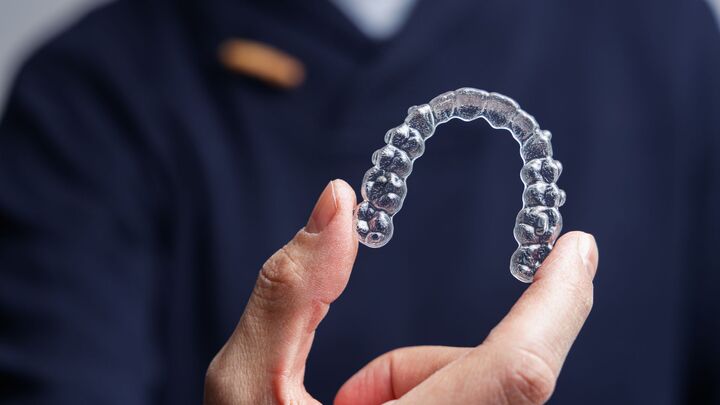Invisalign in Geneva: Benefits and What to Expect
الجسم

The Invisalign system is a set of transparent, detachable aligners that gently shift your teeth into place. Each aligner is custom-fabricated using digital imaging technology, tailored to fit snugly over your teeth. In contrast to braces, a series of sleek, nearly undetectable trays operate in the background instead of wires or brackets.
Why Geneva Is a Prime Destination for Invisalign
Geneva is synonymous with clinical excellence and technological innovation. Invisalign providers here often utilize cutting-edge diagnostic tools like iTero digital scans and 3D planning software. Patients benefit from top-tier orthodontic care, multilingual professionals, pristine clinical settings, and a patient-centered approach deeply rooted in Swiss precision.
Top Benefits of Choosing Invisalign
Aesthetics Without the Metal
Let's face it, metal braces are not the most flattering. With Invisalign, you may straighten your teeth discreetly because the aligners are see-through. It's orthodontics that respects your lifestyle and appearance.
Comfortable, Custom Fit
These aligners are made from SmartTrack material, a proprietary thermoplastic engineered for strength and flexibility. That means fewer mouth abrasions, no poking wires, and a fit so tailored it almost feels like wearing nothing at all.
Removability Means Flexibility
Want to enjoy a caramel-filled dessert? No problem. By allowing you to remove your Invisalign aligners during eating and brushing, you get complete control over your food and oral hygiene routine.
Fewer Orthodontic Visits
With Invisalign, there's no need for monthly wire-tightening appointments. You typically receive several sets of aligners at once and change them at home, checking in with your orthodontist every 6–8 weeks. It's efficient and time-saving.
Enhanced Oral Hygiene
The aligners are detachable so that you may brush and floss normally. This drastically reduces your risk of cavities and gum disease during treatment, something traditional braces can't offer.
The Invisalign Treatment Journey

Initial Consultation and 3D Scanning
Your journey starts with a detailed consultation. The dentist will evaluate your bite, take digital impressions, and map your treatment using advanced software. This ensures predictability and precision from the start.
Aligner Production and Delivery
Once the plan is set, your aligners are manufactured and delivered. To slowly shift your teeth into place, you wear one set for around two weeks and then switch to the next.
Wearing and Switching Aligners
For optimal results, aligners must be worn 20–22 hours daily. You'll be lagging behind your provider's instructions. Following your provider's instructions, you'll switch to a new provider in two weeks. Discipline here is non-negotiable.
Progress Monitoring and Adjustments
Check-ups every few weeks ensure that your teeth are tracking correctly. Minor refinements may be made, and additional aligners might be ordered.
Final Touches: Retainers and Results
Once the active treatment phase ends, you'll receive custom retainers to maintain your results. This final step is essential; teeth can slowly drift back without retention.
Is Invisalign Right for Everyone?
Unfortunately, Invisalign isn't a good fit for every orthodontic case. Complex skeletal issues or severe misalignments may require traditional braces or surgical intervention. However, for mild to moderate spacing, crowding, and bite problems, Invisalign remains a highly effective solution.
Comparing Invisalign with Traditional Braces
Braces are still the go-to for intricate orthodontic corrections. But they come with food restrictions, aesthetic drawbacks, and more discomfort. Invisalign is ideal for individuals who value subtlety, hygiene, and comfort without compromising effectiveness for eligible cases.
Possible Discomfort and Side Effects
You may experience slight pressure when switching to a new aligner, indicating it's working. Some people also report minor lisping during the first few days. These effects are typically short-lived. Serious complications are rare when a qualified provider supervises treatment.
Cost Expectations in Geneva
Invisalign is often perceived as a luxury orthodontic treatment; in Geneva, that perception aligns with reality. The intricacy of your case, the quantity of aligners required, and the level of expertise your provider possesses are the primary factors determining the cost. While it's a significant investment, many find the long-term benefits outweigh the initial expense.
Choosing the Right Invisalign Provider

Experience counts. Find doctors who have completed extensive training as Invisalign specialists and have a history of happy patients. Clinics that offer comprehensive consultations, digital simulations, and transparent pricing models are preferable. Ask for before-and-after photos. Read reviews. This is your smile, entrust it to the best.
Maintaining Results Post-Treatment
After the aligners come off, the work isn't over. Wearing retainers nightly is crucial to preserving your new smile. Fortunately, these retainers are just as discreet and comfortable as your aligners. Maintenance also includes regular dental check-ups and cleanings.
The Long-Term Impact of a Straighter Smile
A well-aligned smile isn't just cosmetic, it's functional. Having your teeth properly aligned lowers your risk of cavities, worn-down teeth, jaw pain, and even speech problems. Psychologically, it boosts self-esteem and encourages better oral hygiene habits. Invisalign is not just about looking better, it's about living better.
Invisalign in Geneva combines modern orthodontic innovation with Swiss-level clinical standards. From invisible aesthetics to lifestyle-friendly flexibility, its benefits are hard to ignore. While the process demands consistency and financial investment, the payoff is a confident, healthy smile that lasts. Whether you're a professional, a student, or someone who values subtle sophistication, Invisalign offers a treatment experience that matches your ambition.
FAQs
1. How long does Invisalign treatment usually take?
Typically between 6 and 18 months, depending on the complexity.
2. Is Invisalign painful?
There's some mild pressure initially, but it's generally less painful than braces.
3. Can I eat with Invisalign in?
No. Aligners must be removed while eating or drinking anything other than water.
4. How often should I wear my aligners?
At least 20–22 hours a day for effective results.
5. Will I need retainers after treatment?
Yes. Retainers are essential to maintain the final position of your teeth.









تعليقات